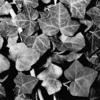- Ivy
-
/uy"vee/, n.a female given name.
* * *
IAny of about five species of evergreen woody vines (rarely shrubs) that make up the genus Hedera in the ginseng family, commonly grown as ground covers and on stone walls, especially English ivy (H. helix), which climbs by aerial roots with adhering disks that develop on the stems.The tough, dark-green leaves of English ivy have three to five lobes and tend to droop horizontally from the stem. Unrelated plants called ivies include Boston ivy (Parthenocissus, or Ampelopsis, tricuspidata), a clinging woody vine in the grape family whose leaves turn bright scarlet in autumn, and poison ivy. English ivy (Hedera helix).Sven SameliusII(as used in expressions)Compton Burnett Dame IvyLee Ivy Ledbetter
English ivy (Hedera helix).Sven SameliusII(as used in expressions)Compton Burnett Dame IvyLee Ivy Ledbetter* * *
▪ plantany plant of the genus Hedera, with about five species of evergreen woody vines (rarely shrubs), in the ginseng family (Araliaceae). The name ivy especially denotes the commonly grown English ivy (H. helix), which climbs by aerial roots with adhering disks that develop on the stems. English ivy is frequently planted to clothe brick walls. The stems bear leaves with three to five lobes; as the stems reach the top of their support, they become horizontal or hang, sometimes developing unlobed (entire) leaves and small greenish flowers. Numerous cultivated and geographical varieties of H. helix exist, including many with variegated leaves. Native to Europe and much of Asia, this genus has been introduced into many parts of the world.Many varieties of ivy are cultivated in gardens. Growing them is an extremely simple matter, as they will thrive in a poor soil and endure a considerable depth of shade, so that they may with advantage be planted under trees. For example, the common Irish ivy (a variety of H. helix) is often used as a ground cover beneath large trees where grass has difficulty in thriving. A strong light is detrimental to the growth of ivy, but there are few hardy plants that may be compared with it for variety and beauty that will endure shade equally well. Ivies, in their many forms, are also popular houseplants.A question of practical importance is the relation of the ivy plant to its means of support. A moderate growth of ivy is not injurious to trees; still, the tendency is from the first unfavourable to the prosperity of the tree, and at a certain stage it becomes deadly. Therefore the growth of ivy on trees should be kept within reasonable bounds. In regard to buildings clothed with ivy, there is nothing to be feared as long as the plant does not penetrate the substance of the wall by means of any fissure. Should it thrust its way in, its natural and continuous expansion hastens the decay of the structure. For unrelated plants called ivies, see Boston ivy; poison ivy.* * *
Universalium. 2010.
